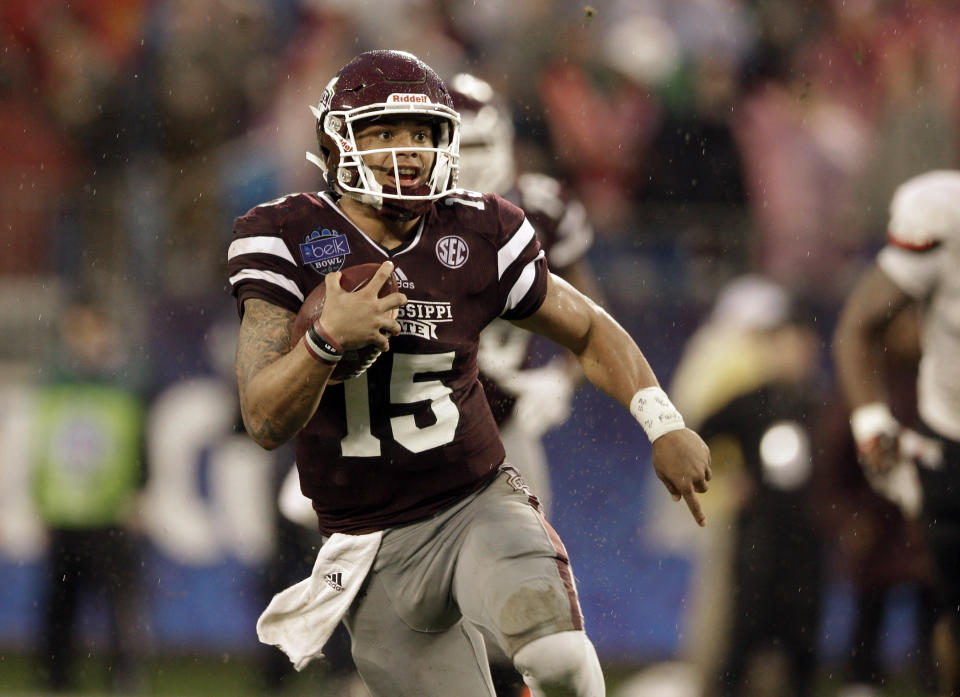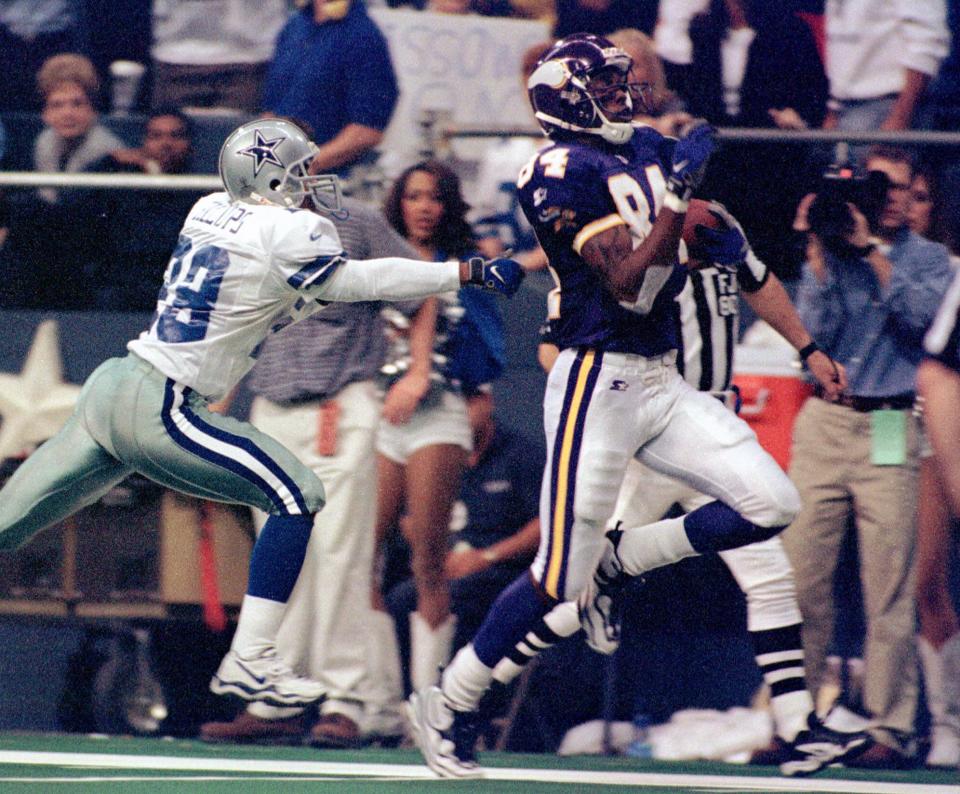Dak Prescott’s pre-draft visit shaped Cowboys destiny. This year, teams will make critical judgments from afar.
It was the run-up to the 2016 NFL draft, and one of those unforeseeable scenarios presented itself to multiple teams. On a mid-March weekend, the cellphones of personnel men with the Dallas Cowboys, Denver Broncos and Arizona Cardinals were suddenly ringing. Mississippi State’s Dak Prescott, one of the more intriguing quarterbacks on their draft boards, had been arrested on an early Saturday morning in Starkville, Mississippi, on suspicion of DUI.
This was a problem. A year before, Prescott was on video during a spring break trip in Florida being assaulted following a verbal altercation at a Waka Flocka Flame concert. The violent clip was splashed across social media platforms. The Cowboys, Broncos and Cardinals had already put that incident to bed after their personnel departments did some legwork at the Senior Bowl and NFL scouting combine. The almost unbelievable Mississippi arrest gave Prescott an issue in the middle of his pre-draft process. And it happened at the very moment three NFL teams were considering trips to Starkville to work him out.
Either Prescott had made an exceedingly stupid mistake, or there was a much bigger character problem that teams had to evaluate. Time was on the side of NFL clubs. The process was still fluid. Trips could be planned. In-person meetings were available. The finishing touches in evaluations, ones that often make or break franchise-changing picks, were still in reach.

And that’s what makes the 2020 NFL draft so interesting. A critical part of that equation has been wiped from the board by the league’s COVID-19 health and safety measures. In the larger picture of world events, it’s an insignificant reality. In the NFL’s stubborn regimen of schedule and routine — which has pressed forward in the face of the coronavirus pandemic — shutting down visits has opened up a world of potential draft mistakes.
“It will change how some teams approach risks,” one general manager said of the NFL’s cancellation of workouts and in-person visits. “The most important part of it is the medical [review]. Usually there are only a couple guys that you’re still making some character judgments on. But the medical — I want to have the best possible information from our doctors. …
“I actually think some teams will be helped by not having guys come in for character questions. The agents have coached them on what to say by now. If a guy can come in and completely change your mind in one visit, you’re looking for a reason to take him and you want to justify it in the building.”
Legendary misses include Randy Moss, Malik McDowell
The NFL’s decision to cut all in-person visits will reveal a great deal about the quality of personnel departments, how they weigh their process and what kinds of risks they’re willing to take. For the front offices that like to roll the dice on questionable character, the visits can be paramount opportunities to confront the talented-but-distressed assets on their draft boards. For franchises that tend to shy away from players with character flags, it’s not as important. So while virtually every personnel department agrees that visits are helpful, the varying reasons why become a microcosm of how differently franchises operate.
There are no shortage of examples, of course. Some infamous, like the Seattle Seahawks changing their mind about their character questions on Malik McDowell after a pre-draft visit in 2017. McDowell had a good enough visit to erase staff concerns, leading the Seahawks to spend a 35th overall pick on him. It proved to be a mistake after McDowell was hurt in an ATV accident and then had multiple ensuing off-field issues.

There is a flip-side, too. Inside the Cowboys, there is a notorious story about how team owner Jerry Jones was in love with Randy Moss’ talent, but then was talked out of the pick after members of the coaching staff didn’t like how Moss acted during an in-person interview.
There’s no end to these stories, particularly where it concerns quarterbacks, who get studied and challenged the most during their visits.
In the late 1990s, the Baltimore Ravens went through an in-person interview with an extremely high-rated quarterback and were stunned when during his interview, the player admitted that his pre-snap adjustments during games were made on the sideline by his head coach, who then signaled in changes for the QB to make. The Ravens downgraded the quarterback, leaving members of the personnel department to delight in the failure of another team when the quarterback went high in Round 1.
A missing tell: Can a player put down his cellphone?
Inside of the past 10 years, another quarterback who was penciled in as a first-round pick for most teams had a run of terrible team visits, almost entirely tied to his insistence on being on his cellphone. After a run of texting and scrolling through social media on two visits, two teams alerted the QB’s agent that the player was being removed from their draft board because of his behavior. He ultimately was selected later than expected and went on to bounce around the league as a journeyman who was never right after his draft experience.
The phone behavior is not an uncommon tell on visits nowadays. It’s one of the first things teams will look at to see if a player can stay focused during visits to facilities. Can the player go most of his day without looking at his phone? Can he shut it off? Does he feel compelled to return text messages in the middle of meetings? These are the things that can’t be answered for teams now since they’re doing their meetings over video chat which is a far cry from getting a player into a contained environment.
The phone behavior isn’t always a no-brainer. A point proven by one very highly acclaimed quarterback who was taken in the past five years. This player got so bored in a meeting with coaches that he started chatting with a member of the team’s personnel department via text. The personnel man was confused, thinking the player’s meeting with coaches must have run unexpectedly short. But when he went to check on the player, he saw the quarterback was still sitting in the meeting and had been texting the personnel man when the coaches had their backs turned to draw up plays on the whiteboard.
Aside from just character questions or medicals, that’s the kind of thing that can end up mattering to a team in the middle rounds, when it’s not uncommon to be on the clock and making a close call between two players, or trying to figure out why someone is sliding down to their pick.
Why Dak Prescott’s draft process factors into today
A player like Prescott became an option in the 2016 NFL draft after guys like Paxton Lynch and Connor Cook were selected in front of the Cowboys. When Prescott was still sitting on the board in Round 4, Dallas chose him over five other available players who had third-round grades from the team. The Cowboys also took him ahead of Jeff Driskel, a quarterback who split his college career at Florida and Louisiana Tech and also had a fourth-round grade on Dallas’ board. It’s worth noting that Driskel was also plotted above Prescott on the team’s war room draft board, which eventually leaked on social media.
This is where Prescott becomes an undeniable example of why the NFL’s pre-draft process of visits and workouts matter. He showcases the way teams attempt to put together a rapport with a potential draft pick and unravel the mysteries — both big and small — that can surround unknowns on a draft board. The kind of in-person work in March and April that can elevate a player from a team’s sub-board, which is where guys with medical or character concerns often go into an undraftable abyss and never return.

For Prescott, the in-person visits made the difference. Partly because it gave him the chance to create an advocate inside the franchise with then-quarterbacks coach Wade Wilson. Also because Prescott had two more opportunities — once in an on-campus workout and another during a visit to Dallas — to address the DUI arrest that he’d later call “the elephant in the room.” Wilson confronted him about it. Former Cowboys head coach Jason Garrett did, too, along with offensive coordinator Scott Linehan. Those conversations were major difference-makers on draft day, when Dallas had its quarterback plans fall apart and was staring at Prescott with the 135th overall pick.
Looking back, you could say it was the four pre-draft visits with Prescott that changed a massive part of Dallas’ future. Not only did it give the team a quarterback to transition to after Tony Romo, but it delivered a player who appears capable of leading the team into a Super Bowl as the surrounding pieces are put into place.
Without those visits, there’s a chance Prescott ends up somewhere else. Maybe Denver or Arizona or some other franchise that would have taken a flier on him as he slid down the board. That is food for thought in this NFL draft, when considering what player might slip through the fingers of a franchise, largely because it couldn’t wrap its hands around all of its questions in the draft process.
More from Yahoo Sports: